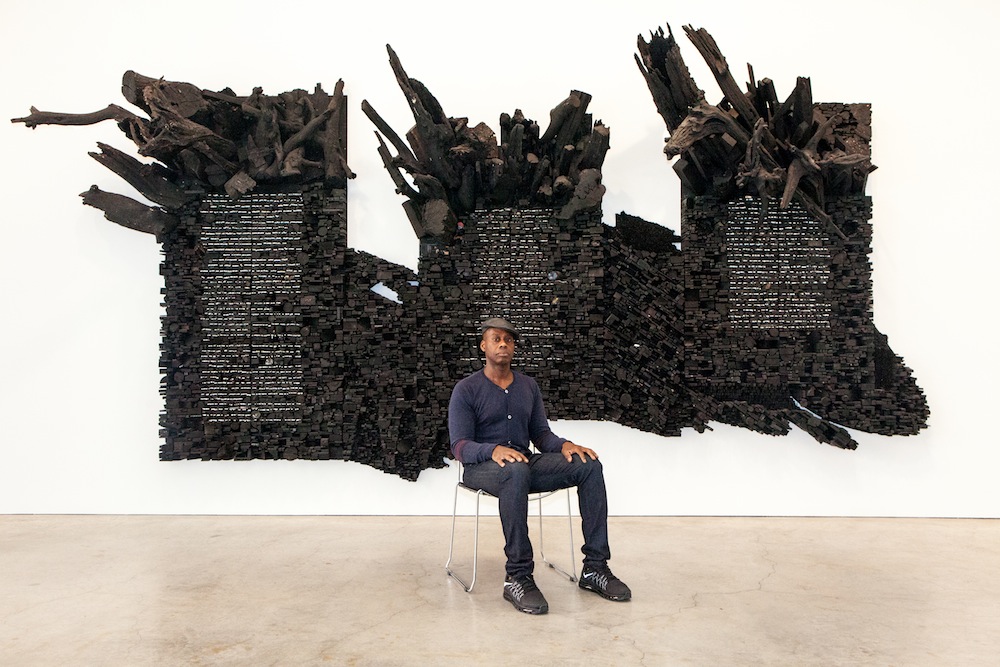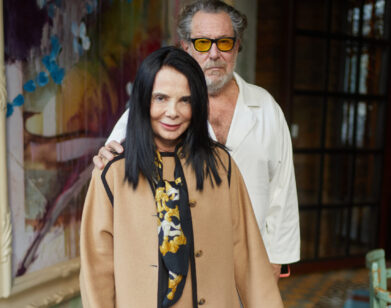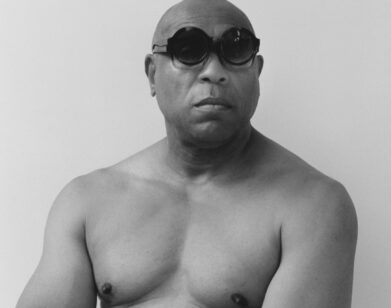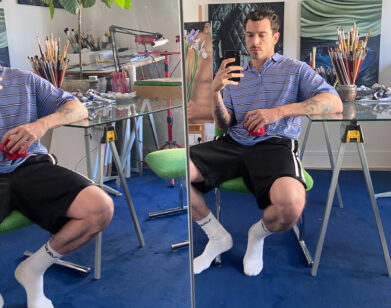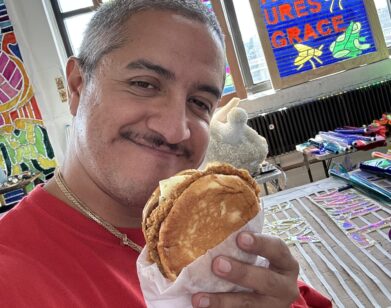Leonardo Drew and The Mother
LEONARDO DREW IN NEW YORK, SEPTEMBER 2016. PHOTOS: ELLIOTT BROWN JR.
“As you’re going through, just stay loose, and digest,” Leonardo Drew tells visitors who approach him at Sikkema Jenkins & Co., where his work is currently on display. Last week during our conversation at the gallery, groups flocked to the artist, seeking elucidations. Drew was kind—always with a smile on his face, usually followed by a laugh—but didn’t fold. He will not explain away his work; instead, he encourages looking and listens to what viewers have to say.
“I think that if allowed, the psychology of your audience can perpetuate something that actually doesn’t even exist,” he tells us. “A lot of my things, they appear found, but I create them in the studio. The black washes, they look burnt, but that’s a wash, it’s layered. When people talk [about the work], I go, ‘That’s interesting.’ I never tell them, ‘That’s not burnt,'” he continues. “I do understand that when it comes to the realization of these things, you are so connected to an ongoing history of us, that you’ve just got to let it flow. It’s a tributary—you’ve got to let it flow.”
Drew’s art-making began early; his debut show at age 13 featured a larger than life-size depiction of Captain America. He continued drawing and painting, but after going on study art at Cooper Union, he left it behind in favor of the abstract. At that time, he experimented, curing dead animals, treating wood, and developed a practice of repurposing past works; it started with Number 8 (1988) which he calls “the mother.” Even today, the mother still finds its way into the works he creates. He breaks down what he’s made, reforms it, and titles it with a new number. His outlook is refreshing, lacking preciousness in favor of layering histories.
This week, his work was given further recognition and context (alongside artists such as Glenn Ligon, Lynette Yiadom-Boakye, and Theaster Gates) in a new publication: Four Generations: The Joyner Giuffrida Collection of Abstract Art (Gregory R. Miller & Co.). The extensive text is an act of art historical reframing through the Joyner Giuffrida collection of abstract works by African American artists and artists of the African Diaspora. According to Drew, Pamela Joyner has been a powerful force behind his career. “It’s one thing to create art, but you do need to have it championed,” he says. “My work is kind of like a tractor-trailer with no driver; it’s going to blow you over. It’s good to actually have a steered force. That would be someone like Pamela. If you’re going to have a tractor-trailer, put a driver in the front.”
HALEY WEISS: I wonder if the creation of these works, and I might be projecting onto them, is at all meditative for you. Internally, what happens when you’re reforming these things that you’ve created to make new objects? These are very physical pieces. They have a real presence.
LEONARDO DREW: They are, but you’ve got to know that if you are working, almost like with layers of the Grand Canyon, there’s history within those layers. The more you touch something, the stronger it becomes. If you’re an artist who’s knocking out paintings, you don’t get to have that opportunity to sort of realize that, but I’ve been living with these things long enough to realize it’s [about] layers. … The longer they hang out, the deeper the history, the richer the life. If you use that as a template or as a way of realizing things, then I don’t think you can go wrong. These things are not precious. They’re lived in.
WEISS: So if you’ve had these items in your studio for a long time, and are reworking them, what is an item that you’re living with now before deciding to incorporate it?
DREW: It could start off as simply as just a wood that’s been store bought. It could be kicking around the studio. I’ve seen some interesting things in terms of what’s on the studio floor—literally what’s on the floor. People would come to the studio in the past—they don’t do this anymore because I stopped this—they would come and say, “Oh, can I have that? You know, it’s just a remnant on the floor.” [claps] Take it, put it in a frame, and it’s like, “Oh, I don’t remember that piece, it’s amazing!” A lot of these things probably started like that. Come, let’s take a look. Physically, you have to actually see what I’m talking about. [walks over to his large-scale wall installation] Say, something as simple as this [small piece]. It started out like that, but because of what goes on in the studio… If you imagine my studio floor, you can just keep picking it up and getting masterpieces. [laughs]
You see how this wood is put together? It’s the same configuration there, but it’s been attacked so many times. One time it was yellow. It could have been other colors. You can see blue right there. It was probably blue at one time.
WEISS: You see its past life.
DREW: Exactly. There are definitely layers … It kept changing on me from one thing to the other. In the end, you just have to listen. They’re speaking to you.
WEISS: You just said it kept changing on you, so it has a life of its own. Is this all instinctual?
DREW: The work will pull you by the nose. You know that you don’t have all the answers, and the unknown is the best place where you would want to be as an artist, not knowing. That actually leads you to ask questions, and it continuously feeds itself. That’s the position I place myself in always. I don’t know. It says follow me. It pulls you right through, just by the nose.
WEISS: A lot has been written about how your environments have informed your work, specifically the housing project in Bridgeport, Connecticut that you grew up in.
DREW: Someone brought up something very interesting that I had not really considered. They talked about smells. Like, the very idea that it wasn’t just that we were right on a dump over landfills, but there was a place where they would melt down animals and make soap. We would see these trucks pull in, and they were stacked with all these animal parts. I hadn’t thought about that when she was asking about smells. I said there was a place called Herman Isaacs, and that was what they did. They melted down animals to make soap, and it smelled terrible. Can you imagine? Soap, a cleaning product, can be made from decay.
I think that’s the cyclical nature of just being, like birth, like death, and regeneration. It’s a very simple map of life. I think that I follow that naturally and organically, without actually ever claiming it, it was just there. I started making work, and it’s like, yes you are calling out all of these things that are part of your memory, your body’s memory, things that have gone through your pores, what you’ve seen, what you’ve experienced, and you spill them out without thinking. I don’t think so much about, “Okay, I’m going to make work, and it’s going to be about this.” It’s just going to come out.
WEISS: It’ll find a way.
DREW: Exactly. It’s been the most honest way of producing work. I think that in the end, I just get out of the way. If there’s a tractor-trailer coming, you’re going to get out of the way, right?
WEISS: Yeah, definitely. Especially if it’s being driven by—
DREW: By nobody. [both laugh]
WEISS: The way you speak about your work, you’re respectful of it, but it’s also, “This is the nature of it.” You let it form itself and you’re just the vehicle through which it’s happening.
DREW: You think I should be more of an intellectual explaining it? [laughs]
WEISS: No, I was going to say, how do you feel about over-intellectualizing works like this, when to you it’s really about that feeling—of life, death, rebirth—these basic things?
DREW: Well, they’re numbered for a reason. They’re numbered because you should have your experience. Why should you be bogged down with my titles and how I thought about it and my poetic reasoning? No, that’s not necessary. Either you’re going to be drawn into it [or not]. It’s a black hole; gravity should pull you in and you should have that experience. Why should I actually infringe and dictate? It’s ridiculous. I learn more from people who have lived with the works. … They go out, people get to live with them, security guards get to stand around them in museums, and they know more in the end about that whole experience, and they tell me things. I listen and I hear and it’s like, “Wow, I hadn’t thought of that.” It’s beautiful. But if I were shut off, and said, “This is what it’s supposed to be about, this is how are you supposed to think about it,” that’s stupid as hell. Why would I want to get in the way of that? In a way, I’m also being educated. It should be not only a synergy, but a complicity between the viewer and the artist, and so I’m wide open to that.
WEISS: Numbering is not not titling. It’s not Untitled.
DREW: It’s cataloging is what it is. … There have been things that have been [numbered] depending on where [they were created], like the L’s were in London, T’s were Texas, S is San Francisco.
WEISS: So it’s really is a log of your life and their lives.
DREW: Absolutely. I mean, if you created something some place, I think in some way, at least for me, I should know where it was created. In a lot of ways, I’m going think about it for me, what that space was where I was creating it, and why it turned out this way. I’m going to China for the month of November to study tri-color glazing with these artisans. I want to know how that could impact my journey, so I’ll spend a month there, and maybe more depending on what I end up getting out of it. The fact is, art is alive. It’s moving around. It’s alive. If we were to talk about my experiences growing up in that landfill, just by osmosis, the fact that I was there taking in all this stuff, this is what the person standing in front of you has made. What can I actually work with in that culture?
WEISS: Art doesn’t exist in a vacuum.
DREW: No. That would be a boring kind of life, especially if the art should be alive, right?
WEISS: Right. I read that you first art show was at 13, so what was in the show?
DREW: Did you ever see that? That was a classic image. We can talk about the politics of that image. Let’s look at it and you can tell me what you’re seeing. [pulls up a photo on his phone of himself at 13 in front of a painting of Captain America]
It’s a political statement in itself. I remember the photographer taking a photo of this. He was laughing, because he was this white hippie guy, and he was like, “Look at this. He has messy buttons. He’s a poor kid from the projects and he’s painting Captain America. What the hell is that about?” It’s a beginning. We can talk all day about this, the politics of that image, but the fact is, when I was getting older, Marvel Comics, DC Comics, Heavy Metal Magazine, they all came after me to work with them. … I might have the facility, but I don’t necessarily have the interest in making that kind of art. ’82 was when I stopped drawing and painting.
WEISS: Did you stop entirely?
DREW: Entirely.
WEISS: Do you miss it?
DREW: No, it’s in you still. … These experiences, all of these things, are in your body. You can’t get them out. It’s like therapy—this is that therapy.
WEISS: The fact that you can pinpoint the year—was there a specific reason you stopped?
DREW: I was doing a lot of exhibiting of a type of work that showed off my facility, from when I was 13 up until my second year of college. I said, “Okay, stop this shit. Enough of this.” What I did was, “Tie your hands. No more drawing, no more painting. Find another way. You have to find another way.” It took, if I remember, seven years—it was ’82 roughly to ’88, ’89. What ended up happening was Number 8.
WEISS: The mother.
DREW: Exactly. But you’ve got to know, that if I start off with Number 8. [laughs]
WEISS: Oh! What about numbers one through seven?
DREW: That’s right—they all became Number 8. You can see them in there.
FOUR GENERATIONS: THE JOYNER GIUFFRIDA COLLECTION OF ABSTRACT ART (GREGORY R. MILLER & CO.) IS OUT NOW. “LEONARDO DREW” IS ON VIEW AT SIKKEMA JENKINS & CO. IN NEW YORK THROUGH OCTOBER 8, 2016.

